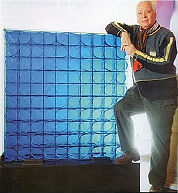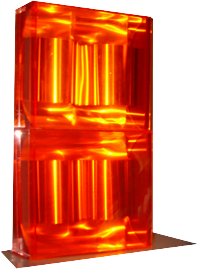MIGUEL ANGEL VIDAL (Buenos Aires, 1928-2009)
Argentine artist, co-founder of the “GENERATIVE ART” movement which adds constructivism, “op-art” (optic art) and geometrical art to tendencies.of its own
 Miguel Angel Vidal graduated from the Prilidiano Pueyrredón National School of Fine Arts (presently named IUNA Visual Arts) in 1952 with the degree of Professo of Visual Arts. Among others his teachers were Lino Enea Spilimbergo and Eugenio Daneri. He was the principal of the same institution from the year 1989 to 1991 and Professor of Painting and Thesis Headmaster at the Ernesto de la Cárcova Superior School of Fine Arts as well.
Miguel Angel Vidal graduated from the Prilidiano Pueyrredón National School of Fine Arts (presently named IUNA Visual Arts) in 1952 with the degree of Professo of Visual Arts. Among others his teachers were Lino Enea Spilimbergo and Eugenio Daneri. He was the principal of the same institution from the year 1989 to 1991 and Professor of Painting and Thesis Headmaster at the Ernesto de la Cárcova Superior School of Fine Arts as well.
He carried out his whole work at his workshop in Buenos Aires, spreading it throughout Argentina and the rest of the world.
He researched on naturalism and studied the line as an expression. With the time his needs for further expression got him involved with Postcubism ending up in the research on Abstraction and Geometry. He was a member of the "Youth Group"(1949-1951) and in 1959 together with Eduardo Mac Entyre he founded the Buenos Aires Movement of Generative Art, promoted by the collector Ignacio Pirovano and the critic Rafael Squirru in 1960.
He carried out one of the first editions of digital art with images created on one of the first existing computers in the country at the Calculus Center of the ORT Schools. Some of the pieces of those editions were exhibited in the Art and Cybernetic Exhibit held at the Bonino Gallery organized by the Art and Communication Center (CAyC) in August 1969. Today these pieces are kept at the Victoria & Albert Museum in London.
 During his Topologic Period Vidal gets interested in the new scientific concepts of the events of such kind which occur in space, developing them to offer a new visual proposal. He works with acrilic and metal boxes to enter real space in three dimensions, in these topologic spaces the light is reflected in concave and convex surfaces which he pours on the canvas.
During his Topologic Period Vidal gets interested in the new scientific concepts of the events of such kind which occur in space, developing them to offer a new visual proposal. He works with acrilic and metal boxes to enter real space in three dimensions, in these topologic spaces the light is reflected in concave and convex surfaces which he pours on the canvas.
As from the late seventies and beginning of the eighties, light gains autonomy and outstands any other element in Vidal´s painting, covering more space and spreading an increased energy. The colour bands appear veiled, the limits are not precise and the curves with melodic rythms are almost tactilely visualized











